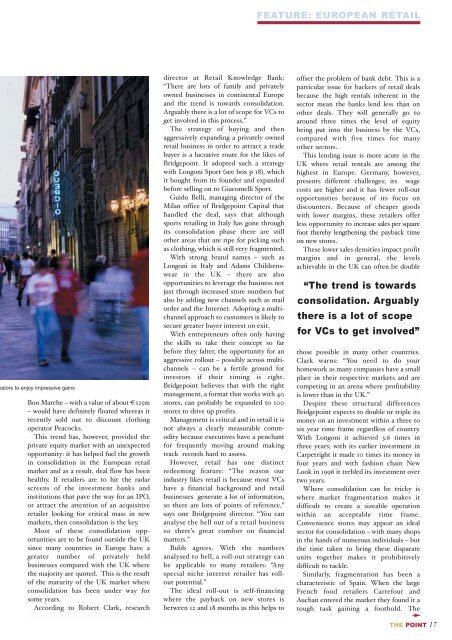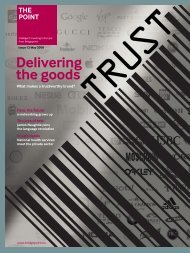Point 2 - 2/11. FINAL - Bridgepoint Capital
Point 2 - 2/11. FINAL - Bridgepoint Capital
Point 2 - 2/11. FINAL - Bridgepoint Capital
Create successful ePaper yourself
Turn your PDF publications into a flip-book with our unique Google optimized e-Paper software.
FEATURE: EUROPEAN RETAILstors to enjoy impressive gainsBon Marche – with a value of about €125m– would have definitely floated whereas itrecently sold out to discount clothingoperator Peacocks.This trend has, however, provided theprivate equity market with an unexpectedopportunity: it has helped fuel the growthin consolidation in the European retailmarket and as a result, deal flow has beenhealthy. If retailers are to hit the radarscreens of the investment banks andinstitutions that pave the way for an IPO,or attract the attention of an acquisitiveretailer looking for critical mass in newmarkets, then consolidation is the key.Most of these consolidation opportunitiesare to be found outside the UKsince many countries in Europe have agreater number of privately heldbusinesses compared with the UK wherethe majority are quoted. This is the resultof the maturity of the UK market whereconsolidation has been under way forsome years.According to Robert Clark, researchdirector at Retail Knowledge Bank:“There are lots of family and privatelyowned businesses in continental Europeand the trend is towards consolidation.Arguably there is a lot of scope for VCs toget involved in this process.”The strategy of buying and thenaggressively expanding a privately ownedretail business in order to attract a tradebuyer is a lucrative route for the likes of<strong>Bridgepoint</strong>. It adopted such a strategywith Longoni Sport (see box p 18), whichit bought from its founder and expandedbefore selling on to Giacomelli Sport.Guido Belli, managing director of theMilan office of <strong>Bridgepoint</strong> <strong>Capital</strong> thathandled the deal, says that althoughsports retailing in Italy has gone throughits consolidation phase there are stillother areas that are ripe for picking suchas clothing, which is still very fragmented.With strong brand names – such asLongoni in Italy and Adams Childrenswearin the UK – there are alsoopportunities to leverage the business notjust through increased store numbers butalso by adding new channels such as mailorder and the Internet. Adopting a multichannelapproach to customers is likely tosecure greater buyer interest on exit.With entrepreneurs often only havingthe skills to take their concept so farbefore they falter, the opportunity for anaggressive rollout – possibly across multichannels– can be a fertile ground forinvestors if their timing is right.<strong>Bridgepoint</strong> believes that with the rightmanagement, a format that works with 40stores, can probably be expanded to 100stores to drive up profits.Management is critical and in retail it isnot always a clearly measurable commoditybecause executives have a penchantfor frequently moving around makingtrack records hard to assess.However, retail has one distinctredeeming feature: “The reason ourindustry likes retail is because most VCshave a financial background and retailbusinesses generate a lot of information,so there are lots of points of reference,”says one <strong>Bridgepoint</strong> director. “You cananalyse the hell out of a retail businessso there’s great comfort on financialmatters.”Bubb agrees. With the numbersanalysed to hell, a roll-out strategy canbe applicable to many retailers: “Anyspecial niche interest retailer has rolloutpotential.”The ideal roll-out is self-financingwhere the payback on new stores isbetween 12 and 18 months as this helps tooffset the problem of bank debt. This is aparticular issue for backers of retail dealsbecause the high rentals inherent in thesector mean the banks lend less than onother deals. They will generally go toaround three times the level of equitybeing put into the business by the VCs,compared with five times for manyother sectors.This lending issue is more acute in theUK where retail rentals are among thehighest in Europe. Germany, however,presents different challenges; its wagecosts are higher and it has fewer roll-outopportunities because of its focus ondiscounters. Because of cheaper goodswith lower margins, these retailers offerless opportunity to increase sales per squarefoot thereby lengthening the payback timeon new stores.These lower sales densities impact profitmargins and in general, the levelsachievable in the UK can often be double“The trend is towardsconsolidation. Arguablythere is a lot of scopefor VCs to get involved”those possible in many other countries.Clark warns: “You need to do yourhomework as many companies have a smallplace in their respective markets and arecompeting in an arena where profitabilityis lower than in the UK.”Despite these structural differences<strong>Bridgepoint</strong> expects to double or triple itsmoney on an investment within a three tosix year time frame regardless of country.With Longoni it achieved 3.6 times inthree years; with its earlier investment inCarpetright it made 10 times its money infour years and with fashion chain NewLook in 1996 it trebled its investment overtwo years.Where consolidation can be tricky iswhere market fragmentation makes itdifficult to create a sizeable operationwithin an acceptable time frame.Convenience stores may appear an idealsector for consolidation – with many shopsin the hands of numerous individuals – butthe time taken to bring these disparateunits together makes it prohibitivelydifficult to tackle.Similarly, fragmentation has been acharacteristic of Spain. When the largeFrench food retailers Carrefour andAuchan entered the market they found it atough task gaining a foothold. TheTHE POINT 17









